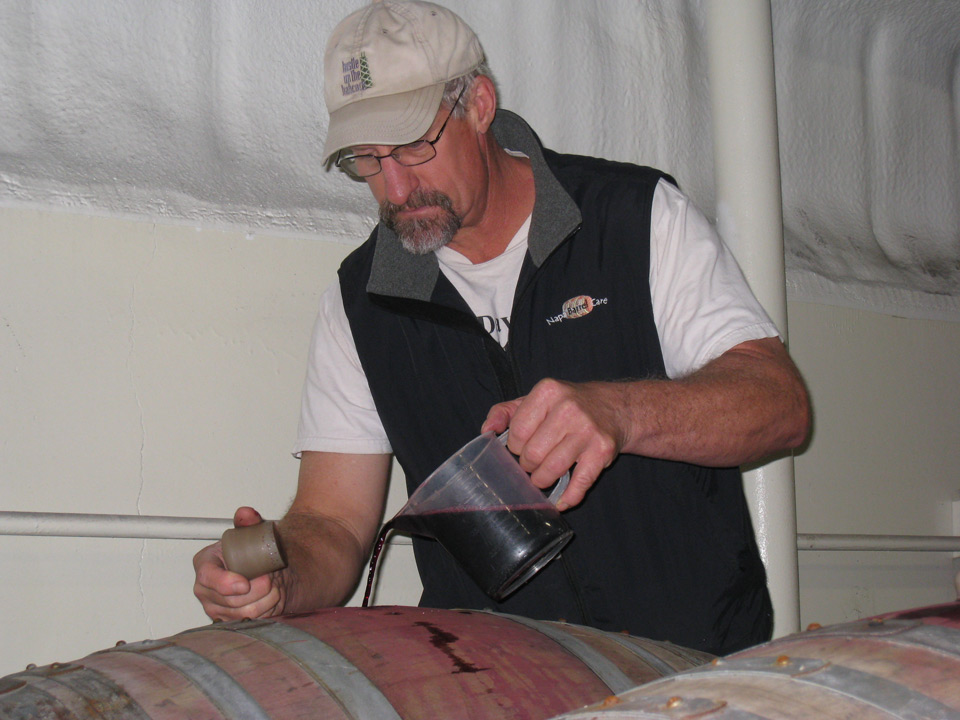
Fruit
Earth
Acidity
Body
Tannins
Producer notes from Lagier Meredith:
"Steve Lagier knows firsthand about vins de garage, having made wine in several garages and carports. He’s been making wine since 1980, first with friends and later at Robert Mondavi Winery in the Napa Valley. After working at Mondavi for 14 years, he left in 1999 to devote all his time to our vineyard and wine. Carole Meredith left her day job in 2003. For 23 years she was a professor in the Department of Viticulture and Enology at the University of California at Davis. She survived the long commute between Napa and Davis with the aid of audio books and stops at every Starbucks between Napa and Davis. In addition to teaching courses, she conducted research in grape genetics. Her research group used DNA profiling methods to discover the origins of some of the greatest old wine varieties, including Cabernet Sauvignon, Chardonnay, Syrah, and Zinfandel.
We bought this property in 1986 and have lived here ever since. The property had been on the market for several years and nobody else wanted it. Other prospective buyers were no doubt put off by the steep, bumpy, rutted 1.5 mile dirt access road and the rather minimal house on the property. We’ve since improved on both the road and the house.
It took us a long time to prepare the land for vines because we both had day jobs at the time. Although the area that we wanted to plant had been cleared, many remaining stumps and roots had to be removed and the soil had to be disked and sown to a grass cover crop to protect it from erosion. We planted the first vines in 1994 and released our first commercial wine in 2000. So it took us a long time to get here. They say that the way to make a small fortune in the wine business in Napa is to start with a large fortune. But we didn’t have any kind of fortune at all, only our paychecks and the willingness to work hard and live cheap.
The vineyard occupies only a small part of our 84-acre property. The rest remains in its natural state—a rich and complex forest composed of redwoods, Douglas fir, madrone, black oak, big leaf maple and bay laurel (and the ubiquitous poison oak). We share the land with deer, turkeys, raccoons, foxes, skunks, bobcats, squirrels, coyotes and the occasional mountain lion. We capture and deport the rattlesnakes that we regularly encounter near the house. (We did kill and eat one once. It really does taste like chicken. Chicken with way too many bones.)"
Steve and Carroll sold their vineyard in 2022 to winemaker Aaron Pott, with whom they had worked for many years, for the sum of $0. Part of the agreement was that they would continue to live on the property and work in the vines for as long as they wish.
About the cuvee:
"Our winemaking is very simple. We don’t sort the fruit in the winery. We prefer to sort in the vineyard. Before harvest, we walk the rows and remove any fruit clusters that aren’t up to our standards, including any clusters with raisined berries or uneven ripening. We don’t use whole clusters. We destem the fruit, although a few stem fragments make it into the fermenters along with the whole berries.
We ferment the wine in food-grade plastic T-bins. These double-walled containers provide enough thermal insulation to keep our fermentations not too hot, not too cold — just right. We punch down two or three times a day. The fermentations typically finish in eight or nine days and we don’t do any extended maceration before we press and barrel the new wine.
 We use only neutral French oak barrels. No new oak. We buy barrels that have already been used three times and then we continue to use the barrels until they begin to fall apart. The wine stays in barrel for 18 to 20 months. We gravity rack after the malolactic fermentation is finished. Then just before bottling we rack to the bottling tank. The wine is unfiltered. Its clarity comes from very careful racking."
We use only neutral French oak barrels. No new oak. We buy barrels that have already been used three times and then we continue to use the barrels until they begin to fall apart. The wine stays in barrel for 18 to 20 months. We gravity rack after the malolactic fermentation is finished. Then just before bottling we rack to the bottling tank. The wine is unfiltered. Its clarity comes from very careful racking."
Lagier Meredith's Tribidrag bottling is particularly noteworthy, as Carole was in charge of the project that ultimately determined the origin of Zinfandel to be the ancient Croatian variety, Tribidrag. Though it had long been thought to be Primitivo (which it is), Carole's groundbreaking work with DNA profiling led to the discovery of its Croatian origin.
